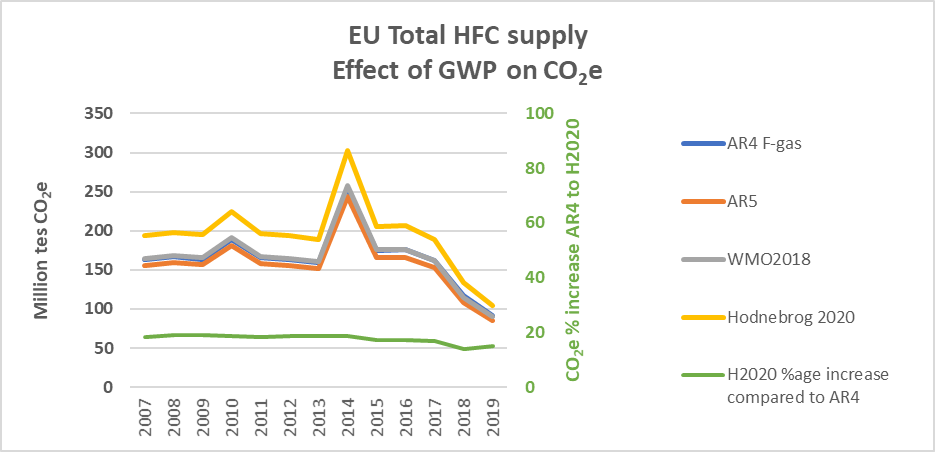REFRIGERANT GWP VALUES: SHOULD MOST RECENT VALUES BE USED FOR THE F-GAS REGULATION?
In its paper, publicized at the 6th May F-gas stakeholders meeting, ECOS discussed how ‘future-proof’ are GWP values. ECOS stated that a problem with environmental policy based on GWP values is that it does not always keep up with the scientific progress. Clearly it is important to periodically review and update the assessments to ensure that the latest scientific data is available. But how significant is this for the policy measures applicable to HFCs?
F-gas Regulation and Kigali Amendment HFC Phase-downs
The UNFCCC adopted AR5 values for reporting emissions under the Paris Agreement and the Montreal Protocol adopted AR4 values for HFC consumption and production under the Kigali Amendment. Both the Kigali Amendment and the F-gas Regulation set baselines and then require consumption reductions against these baselines. Changing the GWPs would also change the baselines, as CO2e, resulting in very limited, if any overall effect, except to cause a discrepancy and confusion between measures/reporting under the Montreal Protocol and EU Regulation. The most important feature is to set a consistent HFC phase-down. The effect of different GWP sets (F-gas AR4, AR5, WMO2018, and Hodnebrog 2020) on the EU total supply as CO2e is shown in the chart. Clearly the different GWP sets have a similar effect on all years including the HFC phase-down baseline years. This is also shown for EU HFC total supply by the percentage increase for CO2e using Hodnebrog 2020 compared to F-gas AR4 GWP values. The percentage increases for 2007 to 2017 are within the range 17 to 19%. The increase is 14-15% in 2018 and 2019 mainly due to a relatively much larger reduction in HFC-143a supply.
When AR6 GWP values are published, which will be based on the Hodnebrog reported values, EFCTC will include them along with AR4, AR5 values in its data tables.
The GWP threshold values contained in the F-gas Regulation are set to encourage the use of lower GWP refrigerants to help deliver the phase-down. These are not arbitrary but selected based on available refrigerants and achievable targets. When these were set the uncertainty in refrigerant GWP values was already known (in the range 30-50%) and any GWP changes do not invalidate the existing policy framework.
An explanation about the changes for the most recent revisions to HFC GWPs is on the EFCTC Learn about selecting and using GWPs for refrigerants June 2021
Chart- EU Reported Total Supply of HFCs, Effect of GWP on CO2e

Chart Explanatory notes:
EEA report for Fluorinated greenhouse gases 2020 is used for HFC total supply, very minor differences (not visible on this chart) are due to some confidential data in the EEA report for minor individual HFCs. The percentage increases for 2007 to 2017 are within the range 17 to 19%. The increase is 14-15% in 2018 and 2019 mainly due to a relatively much larger reduction in HFC-143a supply.
HFC GWP values are relative: The GWP of a HFC is its global warming impact relative to the impact of the same quantity of carbon dioxide over a given time period (usually 100 years). For the GWPs reported by Hodnebrog, changes to the parameters in the absolute AGWPCO2 is the dominant factor for the HFC GWP increases. The GWP(100) values presented in the paper are about 14% higher than if the old AGWPCO2 from AR5 had been used.
1 ECOS Briefing: One step forward, two steps back A deep dive into the climate impact of modern fluorinated refrigerants May 2021
2 Hodnebrog, Ø., Myhre, G., Kramer, R. J., Shine, K. P., Andrews, T., Faluvegi, G., Kasoar, M., Kirkevåg, A., Lamarque, J.-F., Mülmenstädt, J., Olivié, D., Samset, B. H., Shindell, D., Smith, C. J., Takemura, T., Voulgarakis, A.: The effect of rapid adjustments to halocarbons and N2O on radiative forcing, npj Climate and Atmospheric Science, Issue 3, 2020, Pages 1 ff., DOI: https://doi.org/10.1029/2019RG000691